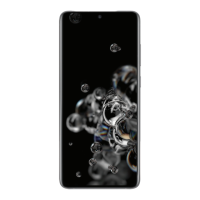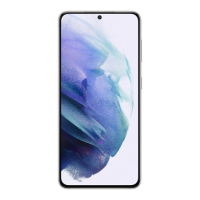
Do you have a question about the Samsung Galaxy S20+ and is the answer not in the manual?
| Resolution | 3200 x 1440 pixels |
|---|---|
| Front Camera | 10 MP |
| Battery Capacity | 4500 mAh |
| Dimensions | 161.9 x 73.7 x 7.8 mm |
| Weight | 186g |
| Water Resistance | IP68 |
| 5G Support | Yes |
| Wireless Charging | Yes |
| Reverse Wireless Charging | Yes |
| Display | 6.7 inches Dynamic AMOLED 2X |
| Processor | Exynos 990 / Qualcomm Snapdragon 865 (region-dependent) |
| RAM | 8GB |
| Storage Options | 128GB / 256GB / 512GB (expandable with microSD) |
| Rear Camera | 12MP (wide) + 64MP (telephoto) + 12MP (ultrawide) |
| Operating System | Android 10, upgradable to Android 13 |
Physical layout and components of the Galaxy S20 5G model.
Physical layout and components of the Galaxy S20+ 5G model.
Physical layout and components of the Galaxy S20 Ultra 5G model.
Initial device setup, including SIM card installation and charging procedures.
Instructions for powering on, setup wizard, data transfer, and basic device operations.
Navigating the camera interface, shooting modes, and specialized camera settings.
Utilizing Augmented Reality features and advanced shooting modes like Live Focus.
Viewing, editing, organizing, and sharing photos and videos in the Gallery.
Enhancing video quality, editing clips, and creating movies from media content.
Capturing screenshots and recording device screen activity for various uses.
Downloading, uninstalling, searching, sorting, and organizing applications.
Accessing and using Samsung-specific applications like Bixby and Galaxy Store.
Utilizing Google apps such as Chrome, Drive, Gmail, and Maps for productivity.
Information on carrier-specific apps and essential Microsoft productivity applications.
Details on security and music applications like McAfee Security and Spotify.
Managing Wi-Fi, Bluetooth, NFC, Mobile Hotspot, and other network connections.
Customizing ringtones, notification sounds, volume, and vibration settings.
Configuring app alerts, status bar visibility, and Do Not Disturb modes.
Adjusting brightness, dark mode, font size, screen timeout, and visual elements.
Optimizing performance, managing battery, storage, and memory resources.
Setting device language, keyboard preferences, and text-to-speech options.
Updating software, resetting various device settings, and performing factory resets.
Securing the device with screen locks, biometrics, and managing security features.
Managing location services, app permissions, and privacy settings.
Adding, managing, syncing, and backing up user accounts and device data.
Configuring settings for vision, hearing, dexterity, and interaction assistance.
Accessing tips, dual messenger functionality, and viewing device information.









